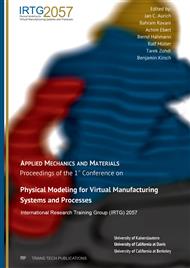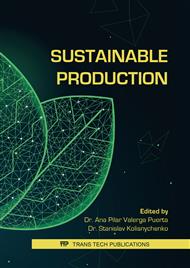[1]
T.W. Zhang, D.A. Dornfeld, Energy Use per Worker-Hour: Evaluating the Contribution of Labor to Manufacturing Energy Use, in: S. Takata, Y. Umeda (Eds. ), Advances in Life Cycle Engineering for Sustainable Manufacturing Businesses, Proceedings of the 14th CIRP Conference on Life Cycle Engineering, Waseda University, Tokyo, Japan, June 11th–13th, 2007, pp.189-193.
DOI: 10.1007/978-1-84628-935-4_33
Google Scholar
[2]
J. Fresner, T. Bürki, H.H. Sittel, Ressourceneffizienz in der Produktion, Kosten senken durch Cleaner Production, first ed. Symposion Publishing GmbH, Düsseldorf, (2009).
Google Scholar
[3]
K. Schischke, E. Hohwieler, R. Feitscher, J. König, S. Kreuschner, P. Wilpert, N.F. Nissen, Energy-Using Product Group Analysis - Lot 5, Machine tools and related machinery, Task 1 Report - Definition, Berlin, Germany, (2012).
Google Scholar
[4]
M. Dervisopoulos, CO$TRA – Life Cycle Costs Transparent, Abschlussbericht, Kurzfassung, PTW, Technische Universität Darmstadt, 2008, pp.26-27.
Google Scholar
[5]
R. Neugebauer, M. Wabner, H. Rentzsch, S. Ihlenfeldt, Structure principles of energy efficient machine tools, In: CIRP Journal of Manufacturing Science and Technology, 2011, No. 4. pp.136-147.
DOI: 10.1016/j.cirpj.2011.06.017
Google Scholar
[6]
E. Abele, Energieeffiziente Produktionsmaschinen durch Simulation in der Produktenwicklung, Ergebnisbericht des BMBF Verbundprojektes eSimPro. (2012).
Google Scholar
[7]
E. Augenstein, J. Nelles, A. Wurm, Energieeffiziente Kühlsysteme für Werkzeugmaschinen - Konzept für eine bedarfsorientierte Kühlwasserversorgung, In: wt Werkstattstechnik online, 2012, Vol. 102, No. 5, pp.306-311.
DOI: 10.37544/1436-4980-2012-5-306
Google Scholar
[8]
G. Mert, C. Bohr, S. Waltemode, J.C. Aurich, Increasing the resource efficiency of machine tools by life cycle oriented services, Procedia CIRP 15 - Proceedings of the 21st CIRP Conference on Life Cycle Engineering, 2014, pp.176-181.
DOI: 10.1016/j.procir.2014.06.065
Google Scholar
[9]
J.C. Aurich, S. Waltemode, Qualität technischer Produkt-Service Systeme, Wt Werkstattstechnik online 102 (2012) 7-8, pp.508-512.
DOI: 10.37544/1436-4980-2012-7-8-508
Google Scholar
[10]
E. Manzini, C. Vezzoli, Product-Service Systems and Sustainability - Opportunities for sustainable solutions, 2001, booklet, Milan, Italy.
Google Scholar
[11]
E. Schweitzer, Lebenszyklusmanagement investiver Produkt-Service Systeme, in: J.C. Aurich (Eds. ), Produkt-Service Systeme - Gestaltung und Realisierung, Springer-Verlag, Berlin, Heidelberg, (2010).
DOI: 10.1007/978-3-642-01407-9_2
Google Scholar
[12]
C. H. Fuchs, Life Cycle Management investiver Produkt-Service Systeme, in: J.C. Aurich (Eds. ), Produktionstechnische Berichte aus dem FBK, Band 04/2007, Kaiserslautern: Techn. Univ., 2007. Zugleich Kaiserslautern, Techn. Univ., Diss., (2007).
Google Scholar
[13]
G. Mert, S. Waltemode, J.C. Aurich, How Services Influence the Energy Efficiency of Machine Tools, A Case Study of a Machine Tool Manufacturer. Procedia CIRP 29 - Proceedings of the 22nd CIRP Conference on Life Cycle Engineering, 2015, pp.287-292.
DOI: 10.1016/j.procir.2015.01.022
Google Scholar



